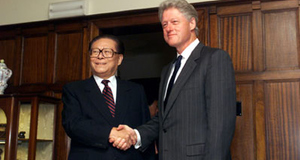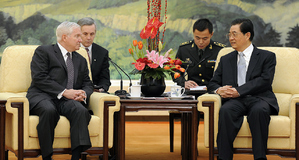From Clocks and Clouds VOL. 7 NO. 1The China Dilemma: A Study of the Ideological Roots of U.S. Foreign Policy Towards China During the Cold WarJimmy Carter's Public StatementsJimmy Carter's public statements surrounding the normalization of relations with China and Deng Xiaoping's subsequent visit also followed the trend of diplomatic talks between the United States and China in that they glossed over the institutional differences between the two countries. In the signing ceremony recognizing the establishment of Sino-American ties, Carter reiterated the strong historical background of the Sino-American relationship by referencing the Chinese-American population: "Almost 700,000 American citizens trace their roots to China. There are strong bonds of blood kinship and history between the United States and China" (Carter 1980, 1773). Moreover, Carter argued that the United States and China have been friends for many years. In remarks after announcing the intended treaty between China and the United States, Carter noted: "the American and the Chinese people had a long history of friendship," which suggested that the Chinese should be seen as brothers and kin rather than as the enemy (Carter 1978, 2265). Despite Carter's attempts to downplay the differences, he still recognized the reality that relations between the United States and China had been very poor since Communist takeover. These strained relations have even led to the potential for war. In a statement welcoming Deng Xiaoping to the United States, Carter iterated that "for the past century and more, our relations have often been marred by misunderstanding, false hopes, and even war" (Carter 1979, 190). Carter recognized that the United States and China had had very tense relations, including during the Korean War when U.S. forces directly combated Chinese forces or in the Vietnam War where China supplied forces hostile to the United States. Interestingly, Carter emphasized that these are mistakes and "misunderstandings," suggesting that publicly at least Carter wanted to recognize that the pre-existing relations were not driven by rational thought, but instead were driven by a lack of information or experience on the part of policymakers on both sides of the Pacific. In other respects, Carter emphasized publicly the United States was avoiding pursuit of a realist framework. In a Question and Answer session on July 11, 1978, Carter states: "I think it would be a serious mistake for ourselves, for the People's Republic of China, for the Soviet Union, to try to play one against another [ …] We would never use China as a lever against the Soviet Union. I think the Chinese people would resent it very deeply, and I think the Soviet Union would also" (Carter, 1263). By consistently emphasizing publicly that the U.S. is not pursuing a strategic framework in developing its relations with China, Carter suggested that speaking in realist terms would be unattractive in the public's eye, and instead used other means of arriving at the same conclusion, which is a balance of power. Finally, moving from recognizing and limiting the reality of the past century of tense relations between the United States and China, Carter also challenged the ideological dichotomization seen in President Johnson's statements by arguing that ideological differences, rather than being a source of fear, could be a source of strength. Carter explicitly recognized that ideological differences can help both the United States and China: "Our histories and our political and economic systems are vastly different. Let us recognize these differences and make them sources not of fear, but of healthy curiosity; not as a source of divisiveness, but of mutual benefit" (Carter 1979, 190). Therefore, by recognizing these differences, both nations could have benefited rather than being limited in relations through the ideological language of the past. Carter also specifically noted the mechanism by which these different ideologies can mutually benefit both nations: "As long as we harbor no illusions about our differences, our diversity can contribute to the vitality of our new relationship. People who are different have much to learn from each other" (Ibid) Therefore, these differences can be sources of strength for both sides. More than that, however, the key component according to Carter is that both sides recognize these mutual differences and do not hold unrealistic expectations about the other side. Comparison Between Jimmy Carter and Lyndon JohnsonThrough the private sources, the Carter and Johnson administrations both focused on the realist, geopolitical implications of the Sino-American relationship. Johnson and his staff emphasized the danger of China's acquisition of an atomic weapon to the security of the United States. Rather than viewing the Chinese as evil just because they are communists, the Johnson administration appeared to view them in more of a power related scenario where Chinese acquisition of this powerful weapon posed a threat to the stability of the United States. The Carter administration continued to view the decisive importance of the Sino-American relationship as a strategic counterweight against the Soviet Union. Similar to the Johnson administration's internal rhetoric, private documents within the Carter administration also lacked a focus on ideological differences between the United States and China and instead viewed the strategic component as more valuable. In their public rhetoric, the situation is very different which reflects the difference in the independent variable. When China assisted the North Vietnamese Communists, then the United States consequently viewed China as an enemy. In this environment, Lyndon Johnson strategically employed ideological language and the dichotomization between freedom and communism to motivate the public against the Chinese communists. This facilitated U.S. foreign policy by encouraging the public to support any retaliatory acts the United States took against China. In the case of Jimmy Carter, the situation is very different. As China was now viewed as a friend, especially after the Sino-Soviet split and Nixon's visit to China, the public rhetoric of Jimmy Carter took a very different direction. Recognizing that Johnson's rhetoric paints a negative picture of China, Carter could not only ignore the ideological differences between the U.S. and China, but he had to cast them in a new light. This necessity led him to emphasize the fact that the ideological differences between the two countries can be a source of strength rather than weakness. While this is the exact opposite reaction of President Johnson, the motives are the same throughout: they are both using ideological rhetoric to influence the mindsets of their constituents to support their policies. As a result, Constructivist argument that ideological influences impact foreign policy decisions of decision makers seems to not hold. Moreover, this portrayal of relations in an ideological suggests that the policymakers did not have autonomy in foreign policy making, but instead were limited by the nonstrategic thinking of their constituents, which trends against the neorealist explanation. In comparison, the neoclassical realist perspective that the government focused on geopolitical aims while the president used ideology to motivate the masses to support the government seems to hold true. In response, the evidence appears to support both of my hypotheses. My first hypothesis was that negative government rhetoric would be more pronounced when the U.S. viewed China as an enemy rather than as a friend. Both presidents support this hypothesis within the context of the public statements. When China was viewed as an enemy during President Johnson's administration, Johnson employed strong rhetoric contrasting the Chinese and Soviet Communists with the free people of Western Europe and the United States. During Carter's administration, on the other hand, Carter goes to great lengths to downplay the importance of the ideological differences between the United States and China. Rather than being negative or even neutral, Carter's administration displayed positive rhetoric regarding the different ideologies of the U.S. and China. My second hypothesis was that public statements would have more ideologically charged statements than private statements. The evidence also supports this hypothesis. Statements pertaining to ideology— both negative for President Johnson and positive for President Carter—played a substantial role within their public statements; however, there is a paucity of ideological language on private statements. Instead, the majority of the language focused on the strategic and power relations between the United States and China. As a result, the realist argument appears to hold sway given the available evidence surrounding these two presidencies. Alternative ExplanationAlthough the evidence appears to support my two hypotheses, there are also alternative explanations and variables that could influence the findings. The first would be the influence of the president himself and whether he had diverging views or perceptions from his advisors. The majority of private statements within the Foreign Relations of the United States series are not from the President himself, but instead focus on different key figures within the Executive Branch of the United States Government. They are primarily conversations between key officials, such as the national security advisor and the secretary of state, and between the State Department and overseas ambassadors. By arguing that the views of these key officials are indicative of the views of the presidential administration, I hold the unitary actor assumption, which treats states as a single entity. Therefore, the views of these key actors would thus be the same as the president. However, as with all assumptions, it may not be realistic. One avenue for future research on this topic would be to explore the perceptions of Presidents Johnson and Carter themselves. This research can be conducted either through diary analysis or through unprepared statements with reporters. A second alternative explanation would be the underlying nature of the independent variable in my research, which is the perception of China as either a friend or an enemy. Throughout this analysis, I took as given that during the Johnson administration the administration viewed China as an enemy. I based this conceptualization on the fact that the U.S. was currently engaged in the Vietnam War and the Chinese were assisting the other side. However, a key limitation to the argument that ideology does not have a noticeable impact on foreign policy is how exactly these perceptions of China as a friend or enemy came into being. One alternative explanation could be that the U.S. engaged in Vietnam for ideological reasons and the Chinese engaged in it for ideological reasons as well, and the U.S. officials formulating foreign policy were taking these ideologies as given and then formulating responses based on them. An alternative explanation would be that, in overt ways, the U.S. foreign policy makers did not take into consideration ideology, but in psychological, cultural, and societal ways they were shaped by the ideology of their time. Although the exceptionally few instances of foreign policymakers taking into consideration ideology when formulating policy argues against this theory, further research on the topic would be necessary to elucidate the influence of underlying societal and cultural perceptions on influencing foreign policy makers. Possible research could compare U.S. foreign policy in the Cold War in what is perceived as a very ideologically charged time period with a similar time period lacking the ideological language. If the realist argument is correct, the foreign policies should be exactly the same. If ideology does have an influence, then the foreign policies would differ. ConclusionRelations between the United States and China took a variety of different forms in the 20th century. From ally in World War II to enemy at the start of the Cold War and then back to friend at the end of the Cold War, a thorough analysis of Sino-American relations would be a tall order; however, my research on two select historical events from this time period suggests that the foreign policymakers prioritized strategy over ideology. By analyzing both the public and private rhetoric of the Johnson and Carter administrations, I tested two hypotheses. The first hypothesis is that negative government rhetoric will be more pronounced when the U.S. viewed China as an enemy rather than as a friend. The presence of negative ideological rhetoric when viewed as an enemy and positive ideological rhetoric when viewed as a friend supports this hypothesis. The second hypothesis is that public statements will have more ideologically charged statements than private statements. Given the focus of the private statements on analyzing the technical and geopolitical implications of China and the focus on public statements for gaining support for U.S. foreign policy, the evidence supports this hypothesis as well. While the Cold War ideological divide between communism and capitalism appeared to fade out with the decline of the Soviet Union, a thorough understanding of the influence of ideology on foreign relations formulation and perceptions of foreign relations formulations, and the divide between the two, remains important to understand. This is because the ideological influences on foreign policy may still exist, but in less overt forms. The reality of present-day SinoAmerican relations is that China remains a communist power. Although numerous scholars and foreign policy analysts differ in how communist China actually is, understanding how ideology and perceptions of that ideology influence foreign policy is important for contemporary understanding of SinoAmerican relations. AuthorAustin Krug is a student of Accounting, Economics, and Chinese He graduates in May of 2018. Kogod School of Business (KSB) and College of Arts & Sciences (CAS), American University. Email: ak8331a@student.american.edu ReferencesBurr, William. "China's First Nuclear Test 1964—50th Anniversary." Washington: The National Security Archive. http://nsarchive.gwu.edu/nukevault/ebb488/. Carter, Jimmy. "Diplomatic Relations between the United States and the People's Republic of China Address to the Nation December 15, 1978." Public Papers of the Presidents of the United States 1978 (1978): 2264-2266. Carter, Jimmy. "Interview With the President: Question-and-Answer Session with West German Reporters." Public Papers of the President of the United States 1978 (1978): 12581263. Carter, Jimmy. "United States-People's Republic of China Agreements Remarks at the Signing Ceremony September 17, 1980." Public Papers of the Presidents of the United States 1980 (1980): 1771-1774. Carter, Jimmy. "Visit of Vice Premier Deng Xiaoping of the People's Republic of China Remarks at the Welcoming Ceremony January 29, 1979." Public Papers of the Presidents of the United States 1979 (1979): 189-191. Christensen, Thomas J. 1996. Useful Adversaries: Grand Strategy, Domestic Mobilization, and Sino-American Conflict, 1947-1958. Princeton: Princeton University Press. "Deng Xiaoping," Encyclopedia Britannica, 2016. http://www.britannica.com/biography/DengXiaoping. Drezner, Daniel W. "Rebooting Republican Foreign Policy." Foreign Affairs 92 1 (2013): 143-152. Foreign Relations of the United States, 1969-1976, Volume XVIII, China, 1973-1976. Edited by Daniel P. Nickles and Edward C. Keefer. Washington: Government Printing Office, 2008. Gaddis, John Lewis. 1997. We Now Know: Rethinking Cold War History. New York: Oxford University Press. Goldstein, Joshua S. and Jon C. Pevehouse. 2012. International Relations. Boston: Pearson Longman. Johnson, Lyndon B. "Radio and Television Report to the American People on Recent Events in Russia, China, and Great Britain October 18, 1964." Public Papers of the Presidents of the United States 1963 (1963-1964): 1377-1380. Kissinger, Henry. 2012. On China. New York: Penguin Group. Lüthi, Lorenz M. 2008. The Sino-Soviet Split: Cold War in the Communist World. Princeton: Princeton University Press. Ralston, David A., David H. Holt, Robert H. Terpstra, and Yu Kai-Cheng. 1997. "The Impact of National Culture and Economic Ideology on Managerial Work Values: A study of the United States, Russia, Japan, and China." Journal of International Business Studies 28 (1): 177-207 Rose, Gideon. Oct. 1998."Neoclassical Realism and Theories of Foreign Policy." World Politics 51 (1): 144-172. "The Third World." Encyclopedia Britannica. 2016. http://www.britannica.com/topic/ThirdWorld. (Accessed: February 3, 2016) Waltz, Kenneth N. 2001. Man, the State, and War. New York: Columbia University Press. "U.S. Relations with China (1949-Present)," Council on Foreign Relations, n.d. (Accessed: 29 March, 2016). http://www.cfr.org/china/us-relations-china-1949---present/p17698 "U.S. Presidential Library," HeinOnline, n.d. http://www.heinonline.org/HOL/Index?collection=presidents&set_as_cursor=cler "Vietnam War," Encyclopedia Britannica Online, 2016. (Accessed: March 28, 2016). http://www.britannica.com/event/Vietnam-War/Tet-brings-the-war-home. Wohlforth, William. 1993. The Elusive Balance: Power and Perceptions During the Cold War. Ithica: Cornell University Press. Endnotes
Suggested Reading from Inquiries Journal
Inquiries Journal provides undergraduate and graduate students around the world a platform for the wide dissemination of academic work over a range of core disciplines. Representing the work of students from hundreds of institutions around the globe, Inquiries Journal's large database of academic articles is completely free. Learn more | Blog | Submit Latest in History |



















